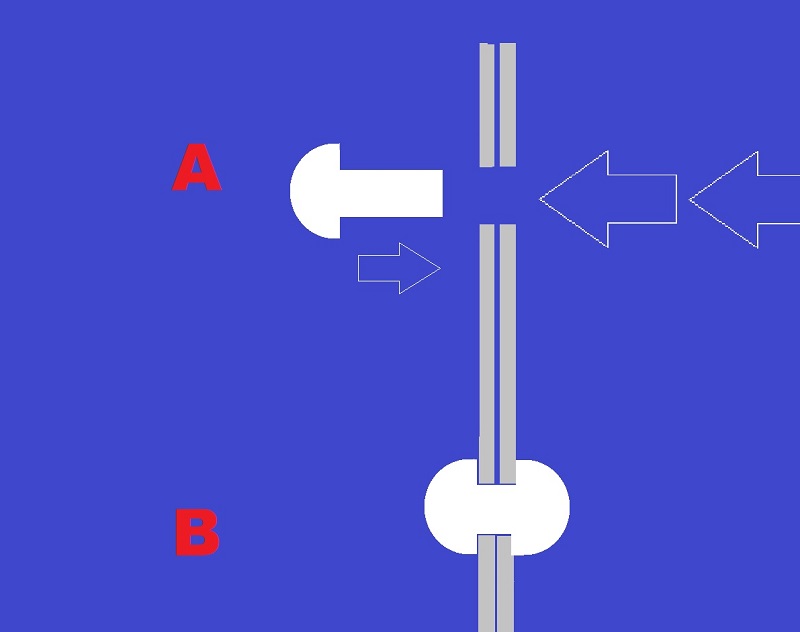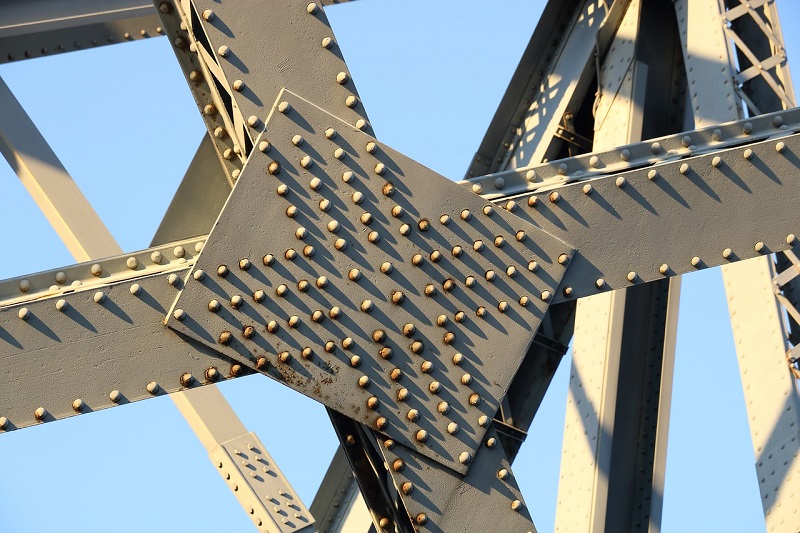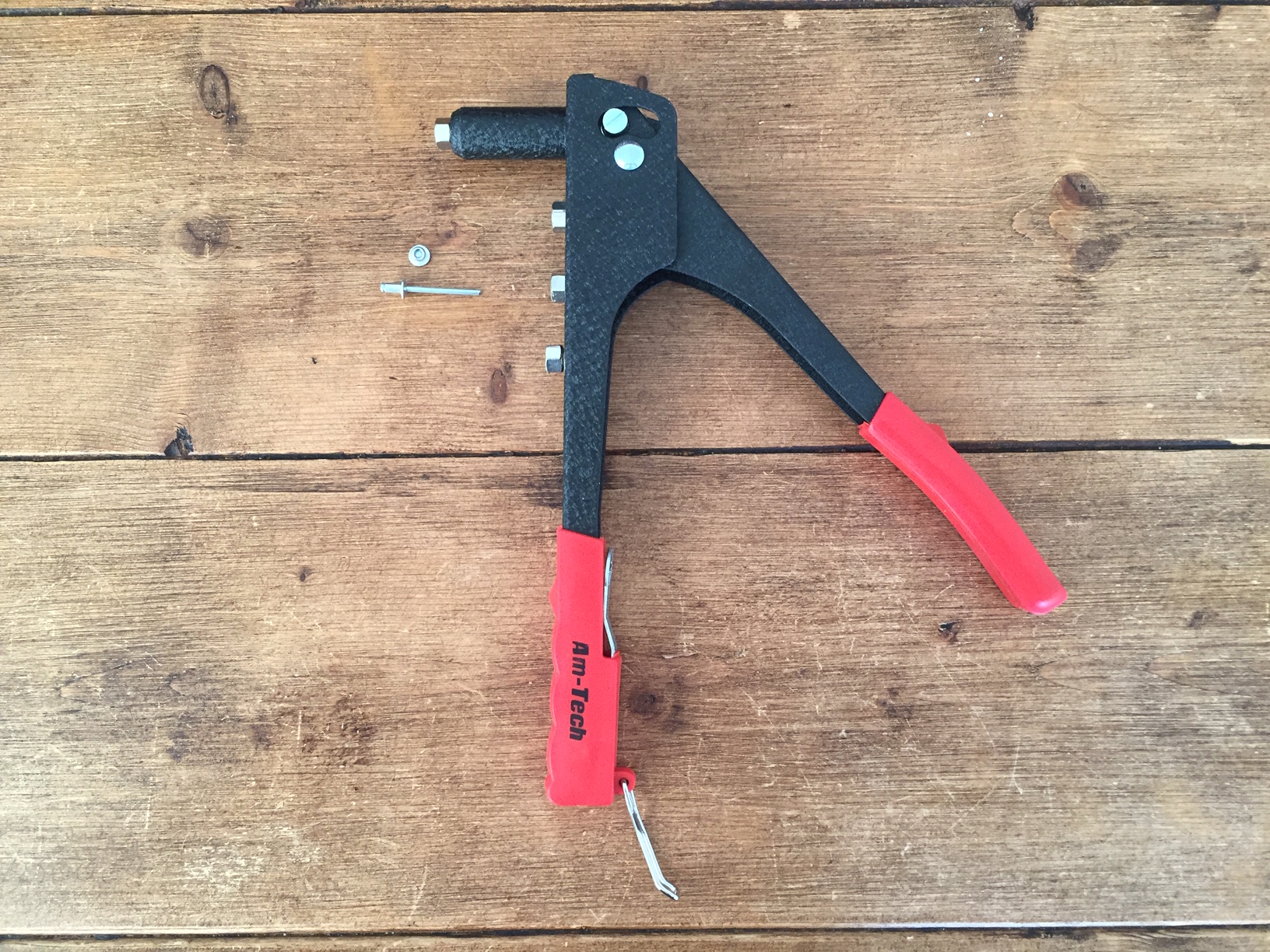Rivet

|
A rivet is a mechanical fastener for making a permanent join between two or more metal sheets. Riveting is the act of fastening or securing two plates with one or more rivets. The rivet comprises a shank with a plain end (or tail), and a head on the other end. The rivet has proved to be one of the most reliable and safe means of fastening, forming a permanent and structurally robust join.
The process of riveting (or making a riveted joint) comprises making a whole in say, two metal plates, aligning the hole, then inserting the rivet through it with the plain end projecting through (‘A’ in the diagram). Hammering the projecting tail end of the rivet causes it to mushroom, expanding by around 1.5 times its original diameter, causing a head to form (‘B’) which secures the rivet and the join permanently. The final shape of the rivet is therefore similar to a dumbbell, with the original head called the factory head and the new tail end called the shop head (or buck tail). The finished rivet can support shear and tension loads.

|
Historically, riveting has been widely used in shipbuilding, bridge building and other areas where steel infrastructure was involved. It was also used in construction but nowadays rarely performed on site but more in the factory, if at all. Typically, this might have been for riveting connecting cleats to steel stanchions and beams, with the final assembly bolted together on site.
Much of the site riveting that took place in construction has been replaced by welding or bolting (bolts typically have the same strength as rivets). Aircraft manufacture makes widespread use of riveting throughout the frame and wings of the plane which can typically require hundreds of thousands of rivets.
Manual hammering is one way of securing a rivet, however in recent times other methods are used to perform the same task and include the use of a hydraulic- or pneumatic-powered air hammer, a rivet gun or a rivet crimping tool. The latter allows the riveting process to be undertaken by one person. Usually, access is required on both sides of the rivet which is why riveting has traditionally been a two-person operation. Where access to the rivet is only possible from one side, the traditional rivet is replaced by a ‘blind rivet’.

|
| Rivet gun and rivets. |
Today, structural steel in construction is mostly assembled using high-strength steel bolts. This is mainly because a bolted connection is cheaper to make than a rivet as it requires lower-skills and fewer workers to complete. Bolts can also be undone.
[edit] Related articles on Designing Buildings
Featured articles and news
The UK's Modern Industrial Strategy: A 10 year plan
Previous consultation criticism, current key elements and general support with some persisting reservations.
Building Safety Regulator reforms
New roles, new staff and a new fast track service pave the way for a single construction regulator.
Architectural Technologist CPDs and Communications
CIAT CPD… and how you can do it!
Cooling centres and cool spaces
Managing extreme heat in cities by directing the public to places for heat stress relief and water sources.
Winter gardens: A brief history and warm variations
Extending the season with glass in different forms and terms.
Restoring Great Yarmouth's Winter Gardens
Transforming one of the least sustainable constructions imaginable.
Construction Skills Mission Board launch sector drive
Newly formed government and industry collaboration set strategy for recruiting an additional 100,000 construction workers a year.
New Architects Code comes into effect in September 2025
ARB Architects Code of Conduct and Practice available with ongoing consultation regarding guidance.
Welsh Skills Body (Medr) launches ambitious plan
The new skills body brings together funding and regulation of tertiary education and research for the devolved nation.
Paul Gandy FCIOB announced as next CIOB President
Former Tilbury Douglas CEO takes helm.
UK Infrastructure: A 10 Year Strategy. In brief with reactions
With the National Infrastructure and Service Transformation Authority (NISTA).
Ebenezer Howard: inventor of the garden city. Book review.
The Grenfell Tower fire, eight years on
A time to pause and reflect as Dubai tower block fire reported just before anniversary.
Airtightness Topic Guide BSRIA TG 27/2025
Explaining the basics of airtightness, what it is, why it's important, when it's required and how it's carried out.
Construction contract awards hit lowest point of 2025
Plummeting for second consecutive month, intensifying concerns for housing and infrastructure goals.
Understanding Mental Health in the Built Environment 2025
Examining the state of mental health in construction, shedding light on levels of stress, anxiety and depression.





















